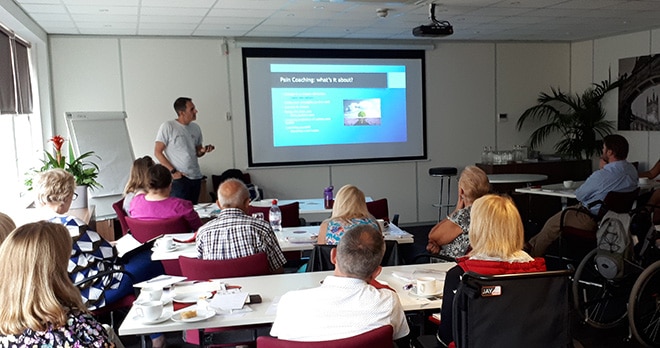CRPS and understanding pain: what can you do to help you?

Richmond Stace is a specialist in pain neuroscience, rehabilitation and nursing. He has extensive experience in working with people suffering with CRPS, giving them an understanding of pain and teaching simple practices that they can integrate into their lives to change pain.
At the event, Richmond asked the audience to think about their pain habits. If your brain is thinking pain, pain, pain, you will automatically think you are still at risk of suffering more pain. It is important to break this cycle by creating a different back story and introduce new patterns of thinking and behaviour.
Richmond encouraged the audience to start by thinking about what their actions and beliefs are. What makes you believe you feel good and strong? This is the first step in helping yourself to work towards getting out of the vicious pain cycle.
There are a number of different factors which can influence pain: emotional state, past experience, tiredness, environment, anticipation, other people -- to name just a few. What we tend to do is focus on our current state, rather than what we need. For example, when we are tired we focus on being tired or what we cannot do because we are tired when we should be focusing on what we need, i.e. sleep.
How you can help yourself get out of the pain cycle
Start by getting a journal. This is the first step to take if you are following Richmond's advice. When you have your journal, write down at the front of it what it is that you want. Focus on this, not what you do not want. This will give you direction and becomes a reference point. You can then going forward ask yourself “am I acting towards my vision or have I been distracted”? If you write your vision down it will become more concrete and you are more likely to work for it.
Write down when you have been successful at something. Write down what strengths helped to achieve that success and how can you use them again. What are your values, what is it that is important to you in life? Values will keep you orientated in the right direction. Align your actions with your values to keep steering you towards success. Work these rather than goals – goals can be dangerous, values keep you aligned. Write down your purpose, a purpose will drive you in the right direction.
At the end of each day write down three good things that have happened and why they were good. Then write down things which you are grateful for.
Your journal is not a pain diary. It will keep you orientated towards what is truly important to you. Journalising will attune you to your thoughts and successes and steer you towards the strengths and values which you first wrote down.
The more you understand about pain the less you fear. Take the energy used worrying and use it to do something. Your journal will help with this. As Richmond says, patients feel more empowered if they understand pain and it puts them back in the driving seat.
Half the battle for CRPS sufferers is finding professionals who understand the condition, whether this be medically to help them with treatment or legally to help them with personal injury claims arising from accidents which have resulted in CRPS. RWK Goodman have a specialist legal team who thoroughly understand CRPS and its effects.
People change and pain can change; get back to life by living life.
If you'd like a copy of the slides from the event, please click here.